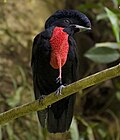| Umbrellabirds | |
|---|---|
 | |
| Long-wattled umbrellabird (Cephalopterus penduliger) | |
| Scientific classification | |
| Kingdom: | Animalia |
| Phylum: | Chordata |
| Class: | Aves |
| Order: | Passeriformes |
| Family: | Cotingidae |
| Genus: | Cephalopterus E. Geoffroy Saint-Hilaire, 1809 |
| Type species | |
| Cephalopterus ornatus [1] E. Geoffroy Saint-Hilaire, 1809 | |
| Species | |
Umbrellabird is the common name referring to three species of birds in the genus Cephalopterus. They are named for their distinct umbrella-like hoods.
Contents
- Basic Information
- Physiology
- Behavior
- Conservation status
- Other names
- Species
- References
- Further reading
The umbrellabird was described by Sir Alfred Wallace, a companion of Charles Darwin, in the 1800s while on an expedition to South America. [2] Umbrellabirds face habitat loss, and two of the three species are at risk of extinction.



